
Устройство двигателя внутреннего сгорания
Содержание
На протяжении столетия в мотоциклах, легковом и грузовом автомобильном транспорте используется двигатель внутреннего сгорания. До сих пор он остается самым экономичным видом мотора. Но для многих остается непонятным принцип действия и устройство ДВС. Попробуем разобраться в основных тонкостях и специфике строения мотора.
📌Определение и общие особенности
Ключевая особенность любого ДВС заключается в воспламенении горючей смеси прямо в его рабочей камере, а не во внешних носителях. В момент горения топлива полученная тепловая энергия провоцирует работу механических компонентов мотора.
📌История создания
До появления ДВС самоходные машины оснащались двигателями внешнего сгорания. Работали такие агрегаты от давления пара, образующегося в результате нагрева воды в отдельном резервуаре.
Конструкция таких двигателей была габаритной и малоэффективной – помимо большого веса установки для преодоления больших расстояний транспорту нужно было тянуть за собой еще и приличный запас топлива (уголь или дрова).
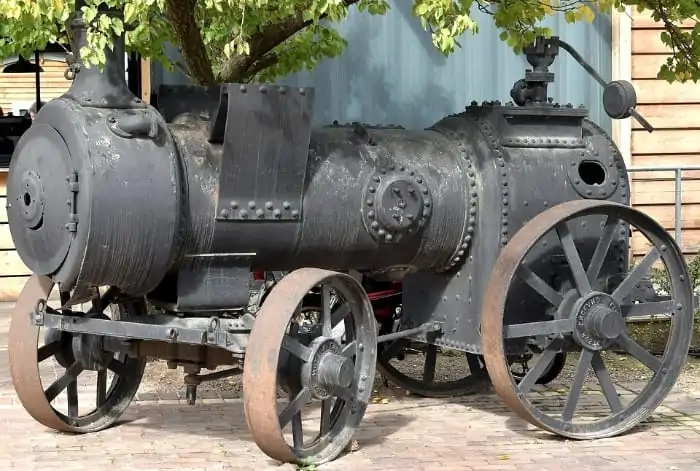
Ввиду такого недостатка инженеры и изобретатели пытались решить важный вопрос: как совместить топливо с телом силового агрегата. За счет удаления из системы таких элементов, как котел, резервуар для воды, конденсатор, испаритель, насос и т.д. можно было значительно снизить вес мотора.
Создание двигателя внутреннего сгорания в привычном для современного автомобилиста виде происходило постепенно. Вот основные вехи, приведшие к появлению современного ДВС:
- 1791г. Джон Барбер изобретает газовую турбину, которая функционировала на основании процесса «перегонки» нефти, угля и древесины в ретортах. Полученный газ вместе с воздухом нагнетался компрессором в камеру сгорания. Образовавшийся горячий газ под давлением подавался на крыльчатку рабочего колеса, и вращал его.
- 1794г. Роберт Стрит патентует жидкотопливный двигатель.
- 1799г. Филипп Лебон в результате пиролиза нефти получает светильный газ. В 1801 году предлагает использовать его в качестве топлива для газовых двигателей.
- 1807г. Франсуа Исаак де Риваз – патент об «использовании взрывающихся материалов, как источника энергии в двигателях». На основании разработки создает «Самодвижущийся экипаж».
- 1860г. Этьен Ленуар впервые воплотил в реальность ранние изобретения, создав работоспособный мотор, работающий от смеси светильного газа и воздуха. Механизм приводился в движение при помощи искры от внешнего источника питания. Изобретение применялось на лодках, но на самоходных машинах не устанавливалось.
- 1861г. Альфонс Бо Де Роша раскрывает важность сжатия топлива перед его воспламенением, что послужило для создания теории работы четырехтактного двс (всасывание, сжатие, горение вместе с расширением и выпуск).
- 1877г. Николаус Отто создает первый четырехтактный ДВС мощностью в 12 л.с.
- 1879г. Карл Бенц патентует двухтактный мотор.
- 1880-е годы. Огнеслав Кострович, Вильгельм Майбах и Готлиб Даймлер параллельно разрабатывают карбюраторные модификации двс, подготавливая их к серийному производству.
Помимо моторов, работающих на бензиновом топливе, в 1899 году появляется «Тринклер-мотор». Данное изобретение – еще одна разновидность двс (бескомпрессорный нефтяной двигатель высокого давления), работающая по принципу изобретения Рудольфа Дизеля. С годами силовые агрегаты, как бензиновые, так и дизельные, совершенствовались, что повышало их КПД.
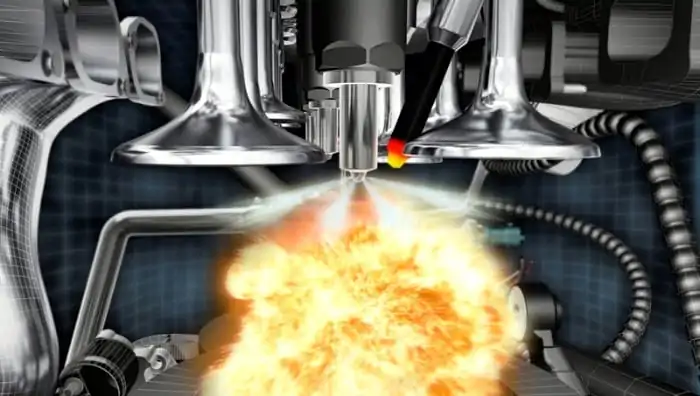
📌Виды ДВС
По типу конструкции и специфике работы ДВС классифицируются по нескольким критериям:
- По типу используемого топлива – дизельные, бензиновые, газовые.
- По принципу охлаждения – жидкостные и воздушные.
- В зависимости от расположения цилиндров – рядные и V-образные.
- По способу приготовления топливной смеси – карбюраторные, газовые и инжекторные (смеси образуются во внешней части ДВС) и дизельные (во внутренней части).
- По принципу зажигания топливной смеси – с принудительным зажиганием и с самовоспламенением (свойственно дизельным агрегатам).
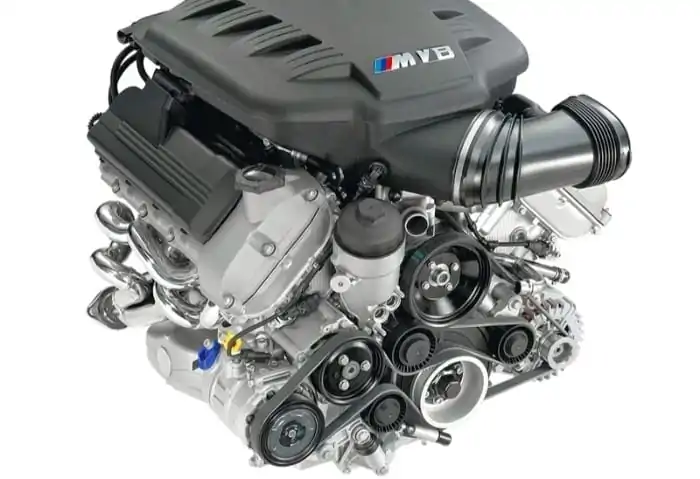
Двигатели также различают по специфике конструкции и эффективности работы:
- Поршневые, у которых рабочая камера локализирована в цилиндрах. Стоит учесть, что такие ДВС делятся на несколько подвидов:
- карбюраторные (карбюратор отвечает за создание обогащенной рабочей смеси);
- инжекторные (поступление смеси происходит непосредственно во впускной коллектор через форсунки);
- дизельные (возгорание смеси происходит за счет создания высокого давления внутри камеры).
- Роторно-поршневые, характеризующиеся преобразованием тепловой энергии в механическую благодаря вращению ротора вместе с профилем. Работа ротора, движение которого по форме напоминает 8-ку, полностью заменяет собой функции поршней, ГРМ и коленвала.
- Газотурбинные, в которых мотор приводится в работу тепловой энергией, получаемой за счет вращения ротора с лопастями, напоминающими по форме клинок. Он и приводит в движение турбинный вал.
Теория, на первый взгляд, кажется понятной. Теперь рассмотрим главные составляющие компоненты силового агрегата.
📌Устройство ДВС
Конструкция корпуса включает такие компоненты:
- блок цилиндров;
- кривошипно-шатунный механизм;
- механизм газораспределения;
- системы подачи и воспламенения горючей смеси и удаления продуктов сгорания (выхлопных газов).
Для понимания места расположения каждого компонента, рассмотрим схему строения мотора:
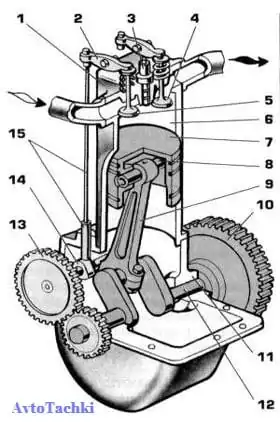
Цифра 6 обозначает место, где расположен цилиндр. Он является одним из ключевых компонентов ДВС. Внутри цилиндра расположен поршень, обозначенный цифрой 7. Он скреплен с шатуном и коленвалом (на схеме обозначены номерами 9 и 12, соответственно). Перемещение поршня внутри цилиндра вверх и вниз провоцирует образование вращательных движений коленвала. На конце колневала предусмотрено наличие маховика, показанного на схеме под цифрой 10. Он необходим для равномерного вращения вала. Верхняя часть цилиндра оснащена плотной головкой, имеющей клапаны впуска смеси и выпуска отработанных газов. Они показаны под цифрой 5.
Открытие клапанов становится возможным за счет кулачков распредвала, обозначенного номером 14, а точнее — его передаточных элементов (номер 15). Вращение распредвала обеспечивают шестерни коленвала, обозначенные цифрой 13. При свободном перемещении поршня в цилиндре он способен занять два крайних положения.
Обеспечить нормальную работу ДВС может только равномерная подача топливной смеси в нужный момент. Чтобы уменьшить рабочие затраты мотора на отвод тепла и предотвратить преждевременный износ движущих компонентов, их смазывают маслом.
📌Принцип работы ДВС
Современные ДВС работают от воспламенившегося топлива внутри цилиндров и энергии, которая появилась в результате этого. Через впускной клапан (во многих двигателях их по два на цилиндр) подается смесь бензина и воздуха. Там же она воспламеняется за счет искры, которую образует свеча зажигания. В момент мини взрыва газы в рабочей камере расширяются, создавая давление. Оно приводит в движение поршень, прикрепленный к КШМ.
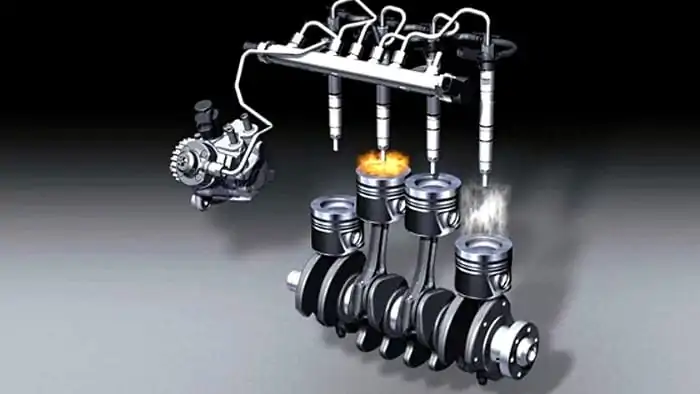
Дизели работают по похожему принципу, только процесс горения инициируется несколько иначе. Вначале воздух в цилиндре сжимается, что приводит его к нагреву. Перед тем, как поршень достигнет ВМТ в такте сжатия, форсунка распыляет топливо. Из-за горячего воздуха топливо загорается самостоятельно без искры. Далее процесс идентичен бензиновой модификации двс.
КШМ преобразует возвратно-поступательные движения поршневой группы во вращение коленчатого вала. Крутящий момент идет на маховик, затем на механическую или автоматическую КПП и в завершение – на ведущие колеса.
Процесс во время движения поршня вверх или вниз называется тактом. Все такты до момента их повторения называются циклом.
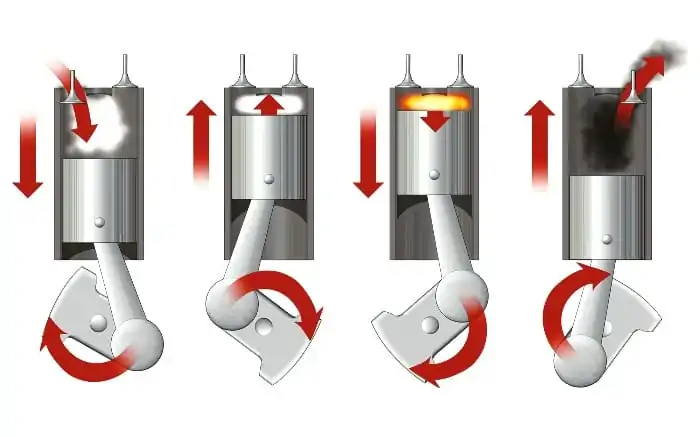
В один цикл входит процесс всасывания, сжатия, воспламенения вместе с расширением образовавшихся газов, выпуска.
Существует две модификации моторов:
- В двухтактном за цикл коленвал оборачивается один раз, а поршень опустится вниз и поднимется вверх.
- В четырехтактном за цикл коленвал провернется два раза, а поршень совершит четыре полных движения – опустится, поднимется, опустится, поднимется.
📌Принцип работы двухтактного двигателя
Когда водитель запускает мотор, стартер приводит в движение маховик, коленвал проворачивается, КШМ перемещает поршень. Когда он достигает НМТ и начинает подниматься, рабочая камера уже заполнена горючей смесью.
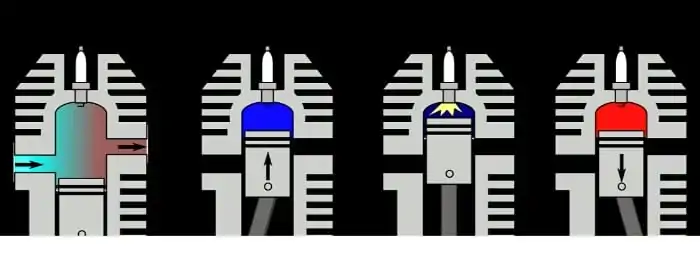
В ВМТ поршня она воспламеняется, и перемещает его вниз. Далее происходит вентиляция – отработанные газы вытесняются новой порцией рабочей горючей смеси. В зависимости от устройства мотора продувка может происходить по-разному. Одна из модификаций предусматривает заполнение топливно-воздушной смесью подпоршневого пространства, когда он поднимается, а когда поршень опускается, она выдавливается в рабочую камеру цилиндра, вытесняя продукты горения.
В таких модификациях моторов нет клапанной системы газораспределения. Сам поршень открывает/закрывает впускное/выпускное отверстие.
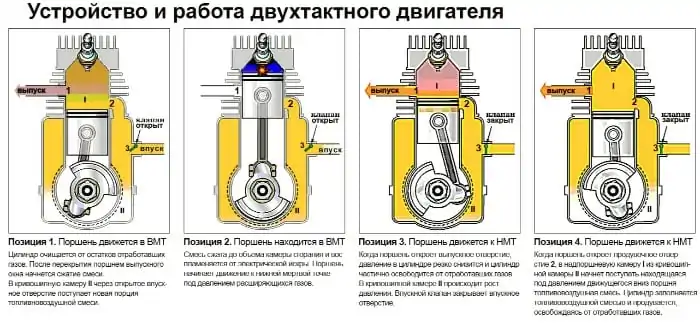
Подобные моторы используются в маломощной технике, потому что газообмен в них происходит за счет замещения отработанных газов очередной порцией воздушно-топливной смеси. Так как вместе с выхлопом частично удаляется и рабочая смесь, данная модификация отличается повышенным расходом топлива и меньшей мощностью по сравнению с четырехтактными аналогами.
Одно из преимуществ таких двс – меньше трения за один цикл, но при этом они сильней нагреваются.
📌Принцип работы четырехтактного двигателя
Большинство автомобилей и других механических транспортных средств оснащаются четырехтактными моторами. Для подачи рабочей смеси и отвода отработанных газов используется механизм газораспределения. Он приводится в движение через привод ГРМ, соединенный со шкивом коленвала ременной, цепной или шестеренчатой передачей.
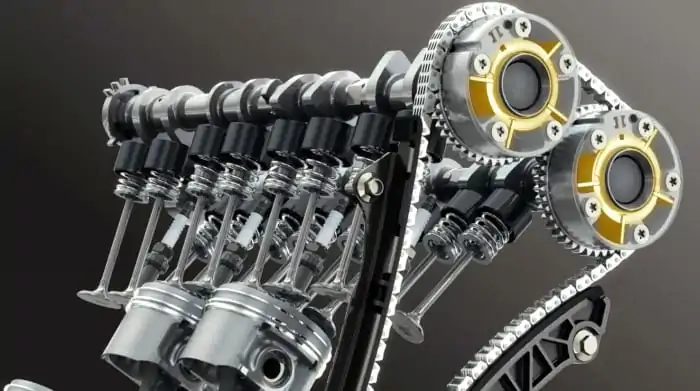
Вращающийся распредвал поднимает/опускает впускные/выпускные клапаны, находящиеся над цилиндром. Данный механизм обеспечивает синхронность открытия соответствующих клапанов для подачи горючей смеси и отвода отработанных газов.
В таких двигателях цикл происходит следующим образом (на примере бензинового двс):
- В момент запуска мотора стартер проворачивает маховик, который приводит в движение коленвал. Открывается впускной клапан. Кривошипно-шатунный механизм опускает поршень, создавая вакуум в цилиндре. Происходит такт всасывания воздушно-топливной смеси.
- Перемещаясь из нижней мертвой точки вверх, поршень сжимает горючую смесь. Это второй такт – сжатие.
- Когда поршень находится в верхней мертвой точке, свеча создает искру, которая воспламеняет смесь. Из-за взрыва происходит расширение газов. Избыток давления в цилиндре перемещает поршень вниз. Это третий такт – воспламенение и расширение (или рабочий ход).
- Вращающийся коленвал перемещает поршень вверх. В этот момент распредвал открывает выпускной клапан, через который поднимающийся поршень вытесняет отработанные газы. Это четвертый такт – выпуск.
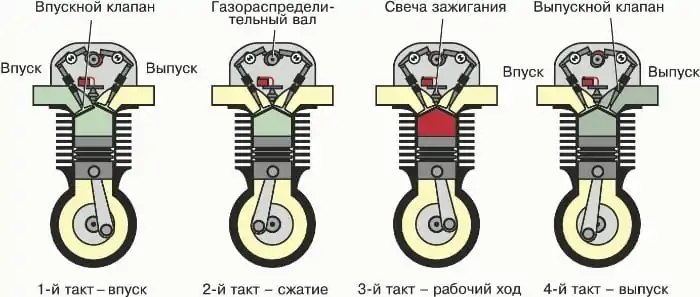
📌Вспомогательные системы двигателя внутреннего сгорания
Ни один современный двигатель внутреннего сгорания не способен работать самостоятельно. Это так, потому что топливо нужно доставить от бензобака до мотора, оно должно в нужный момент воспламениться, а чтобы двигатель не «задохнулся» от выхлопных газов, их нужно вовремя удалить.
Вращающиеся детали нуждаются в постоянной смазке. Из-за повышенных температур, образующихся в процессе горения, двигатель нужно охладить. Эти сопутствующие процессы не обеспечиваются самим мотором, поэтому ДВС работает вместе со вспомогательными системами.
📌Система зажигания
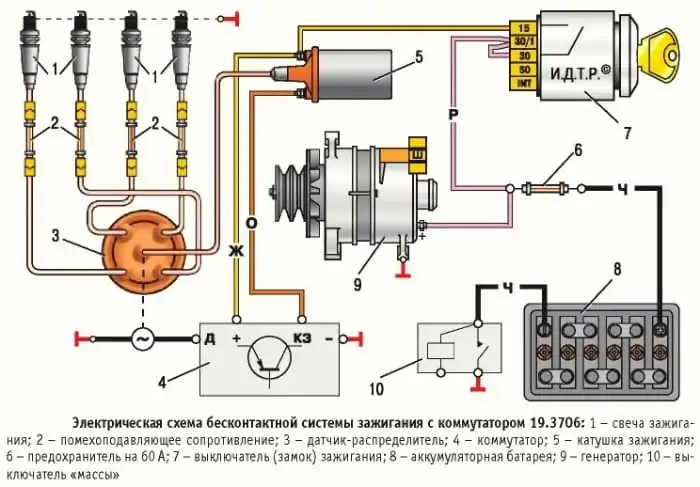
Данная вспомогательная система предназначена для своевременного воспламенения горючей смеси при соответствующем положении поршня (ВМТ в такте сжатия). Она используется на бензиновых двигателях внутреннего сгорания и состоит из таких элементов:
- Источник питания. Когда мотор находится в спокойном состоянии, эту функцию выполняет аккумуляторная батарея (как завести авто, если аккумулятор сел, читайте в отдельной статье). После запуска двигателя в качестве источника энергии выступает генератор.
- Замок зажигания. Устройство, которое замыкает электрическую цепь для ее запитывания от источника питания.
- Накопитель. В большинстве бензиновых автомобилях стоит катушка зажигания. Есть также модели, в которых таких элементов несколько – по одной на каждой свече зажигания. Они преобразуют низкое напряжение, идущее от АКБ, в ток высокого напряжения, которое нужно для создания качественной искры.
- Распределитель-прерыватель зажигания. В карбюраторных автомобилях это трамблер, в большинстве остальных этот процесс контролируется ЭБУ. Такие устройства распределяют электрические импульсы на соответствующие свечи зажигания.
📌Впускная система
Для создания процесса горения необходима совокупность трех факторов: топлива, кислорода и источника воспламенения. Если подать электрический разряд – задача системы зажигания, то впускная система обеспечивает поступление кислорода в двигатель, чтобы горючее смогло воспламениться.
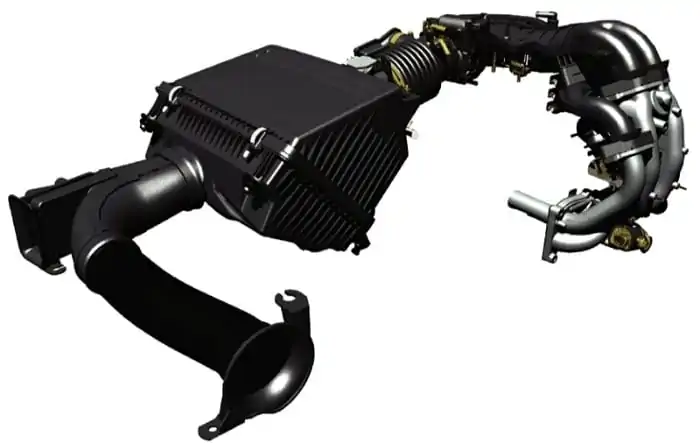
Данная система состоит из:
- Воздухозаборника – патрубка, через который происходит забор чистого воздуха. Процесс поступления зависит от модификации двигателя. В атмосферных моторах происходит всасывание воздуха за счет создания вакуума, образующегося в цилиндре. В турбированных моделях данный процесс усиливается за счет вращения лопастей нагнетателя, что увеличивает мощность мотора.
- Фильтр воздуха предназначен для очистки потока от пыли и мелких частиц.
- Дроссельной заслонки – клапана, регулирующего количество поступающего в мотор воздуха. Регулируется либо нажатием на педаль акселератора, либо электроникой блока управления.
- Впускного коллектора – системы труб, соединенных в одну общую трубу. В инжекторных двс сверху устанавливается дроссельная заслонка и для каждого цилиндра по топливной форсунке. В карбюраторных модификациях на впускном коллекторе установлен карбюратор, в котором происходит смешивание воздуха с бензином.
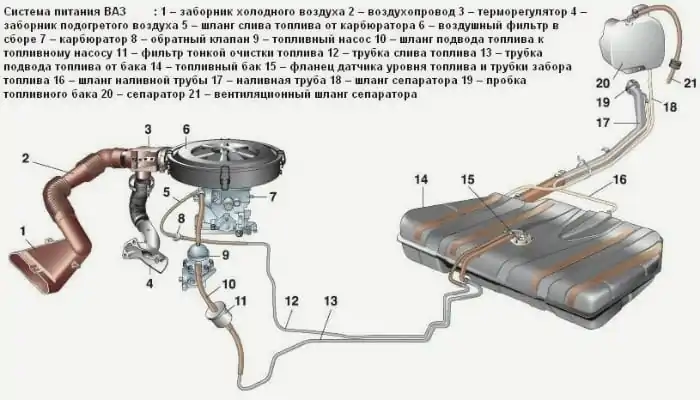
Помимо воздуха в цилиндры нужно подать и топливо. Для этой цели разработана топливная система, состоящая из:
- топливного бака;
- топливной магистрали – шланги и трубки, по которым от резервуара до мотора движется бензин или дизтопливо;
- карбюратора или инжектора (систем форсунок, распыляющих горючее);
- топливного насоса, перекачивающего горючее из бака в карбюратор или другое устройство для смешивания топлива и воздуха;
- топливного фильтра, очищающего бензин или ДТ от мусора.
На сегодняшний день существует много модификаций моторов, в которых рабочая смесь подается в цилиндры разными методами. Среди таких систем существуют:
- моновпрыск (принцип карбюратора, только с форсункой);
- распределенный впрык (для каждого цилиндра устанавливается отдельная форсунка, воздушно-топливная смесь формируется в канале впускного коллектора);
- непосредственный впрыск (форсунка распыляет рабочую смесь непосредственно в цилиндр);
- комбинированный впрыск (сочетает в себе принцип непосредственного и распределенного впрыска)
📌Система смазки
Все трущиеся поверхности металлических деталей необходимо смазать для охлаждения и уменьшения их износа. Чтобы обеспечить такую защиту, мотор оснащается системой смазки. Она также обеспечивает защиту металлических деталей от окисления и удаляет нагар. Система смазки состоит из:
- поддона картера – резервуара, в котором находится моторное масло;
- масляного насоса, создающего давление, благодаря которому смазка поступает во все узлы мотора;
- масляного фильтра, задерживающего любые частицы, образующиеся в результате работы мотора;
- некоторые автомобили оснащаются масляным радиатором для дополнительного охлаждения смазки мотора.
📌Выхлопная система
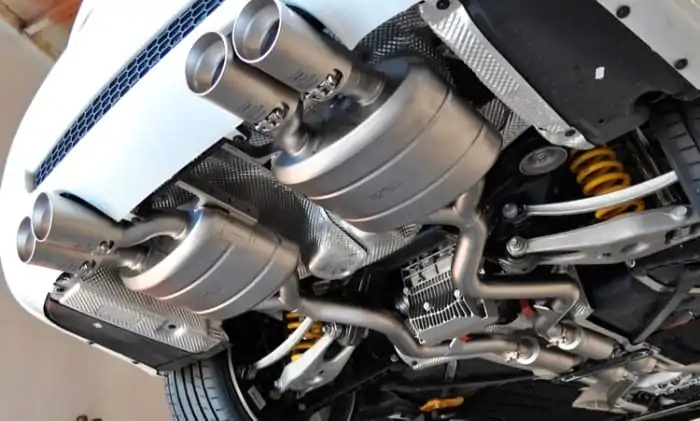
Качественная выхлопная система обеспечивает удаление отработанных газов из рабочих камер цилиндров. Современные автомобили оснащены системой выхлопа, в которую входят следующие элементы:
- выпускной коллектор, в котором гасятся вибрации горячих отработанных газов;
- приемная труба, в которую отработанные газы поступают из коллектора (подобно выпускному коллектору изготавливается из жаростойкого металла);
- катализатор, очищающий отработанные газы от вредных элементов, что позволяет транспортному средству соответствовать экологическим нормам;
- резонатор – емкость, немногим меньшая основного глушителя, предназначенная для снижения скорости выхлопа;
- основной глушитель, внутри которого находятся перегородки, изменяющие направление отработанных газов для снижения их скорости и шума.
📌Система охлаждения
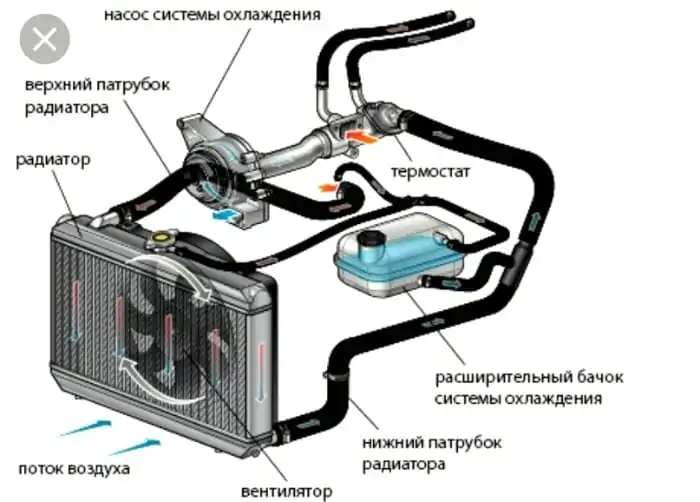
Данная дополнительная система позволяет работать мотору без перегрева. Она поддерживает рабочую температуру двигателя, пока он заведен. Чтобы этот показатель не превышал критические границы даже когда машина стоит, система состоит из таких деталей:
- радиатор охлаждения, состоящий из трубок и пластин, предназначенных для быстрого теплообмена между охлаждающей жидкостью и воздухом окружающей среды;
- вентилятор, обеспечивающий подачу большего потока воздуха, например, если машина стоит в пробке и радиатор не обдувается в достаточной степени;
- водяная помпа, благодаря которой обеспечивается циркуляция охлаждающей жидкости, отводящей тепло от горячих стенок блока цилиндров;
- термостат – клапан, который открывается после того, как мотор прогреется до рабочей температуры (до его срабатывания ОЖ циркулирует по малому кругу, а когда он открывается – жидкость движется через радиатор).
Синхронная работа каждой вспомогательной системы обеспечивает бесперебойную работу ДВС.
📌Циклы двигателя
Под циклом подразумеваются действия, которые повторяются в отдельном цилиндре. Четырехтактный мотор оснащается механизмом, который обеспечивает срабатывание каждого из этих циклов.
В ДВС поршень выполняет возвратно-поступательные движения (вверх/вниз) по цилиндру. Шатун и кривошип, закрепленный на нем, преобразует эту энергию во вращение. Во время одного действия – когда поршень доходит от нижней точки до верхней и обратно – коленчатый вал делает один оборот вокруг своей оси.
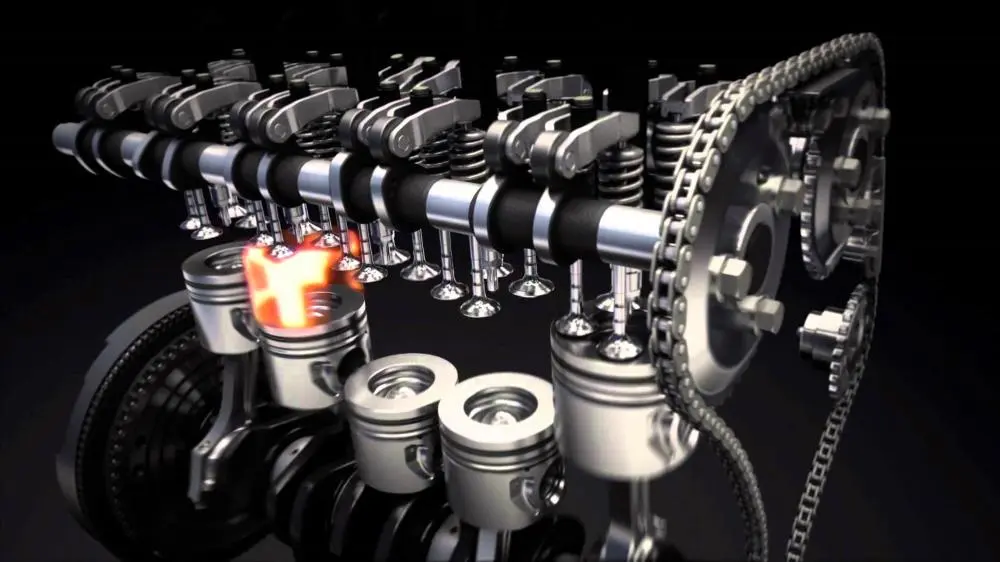
Чтобы этот процесс происходил постоянно, в цилиндр должна поступать воздушно-топливная смесь, она должна в нем сжиматься и воспламеняться, а также должны удаляться продукты горения. Каждый из этих процессов происходит за один оборот коленвала. Эти действия называются тактами. Всего в четырехтактнике их четыре:
- Впуск или всасывание. На этом такте в полость цилиндра всасывается воздушно-топливная смесь. Она поступает через открытый впускной клапан. В зависимости от типа топливной системы бензин смешивается с воздухом во впускном коллекторе или непосредственно в цилиндре, как, например, у дизелей;
- Сжатие. В этот момент как впускной, так и выпускной клапаны закрыты. Поршень идет вверх благодаря провороту коленвала, а он вращается за счет выполнения других тактов в смежных цилиндрах. В бензиновом моторе ВТС сжимается до нескольких атмосфер (10-11), а в дизеле – более 20атм.;
- Рабочий ход. В момент, когда поршень остановится в самом верху, сжатая смесь зажигается при помощи искры от свечи зажигания. В дизельном агрегате этот процесс несколько отличается. В нем воздух так сильно сжимается, что его температура подскакивает до значения, при котором солярка загорается самостоятельно. Как только происходит взрыв смеси топлива и воздуха, высвободившейся энергии некуда деваться, и она перемещает поршень вниз;
- Выпуск продуктов горения. Чтобы камера наполнилась свежей порцией горючей смеси, газы, образовавшиеся в результате воспламенения, необходимо удалить. Это происходит в следующем такте, когда поршень идет вверх. В этот момент открывается выпускной клапан. При достижении поршнем верхней мертвой точки цикл (или совокупность тактов) в отдельном цилиндре замыкается, и процесс повторяется.
📌Преимущества и недостатки ДВС
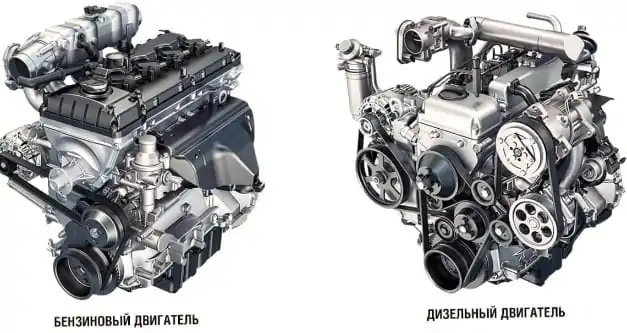
На сегодняшний день оптимальный вариант двигателей для механических транспортных средств – ДВС. Среди преимуществ таких агрегатов можно выделить:
- простота в ремонте;
- экономичность для дальних поездок (зависит от его объема);
- большой рабочий ресурс;
- доступность для автомобилиста среднего достатка.
Идеального мотора пока еще не создали, поэтому данные агрегаты имеют и некоторые недостатки:
- чем сложнее агрегат и сопутствующие системы, тем дороже их обслуживание (пример – моторы EcoBoost);
- требует тонкую настройку системы подачи топлива, распределения зажигания и других систем, что требует определенных навыков, иначе мотор будет работать не эффективно (или вообще не заведется);
- больший вес (по сравнению с электрическими двигателями);
- износ кривошипно-шатунного механизма.
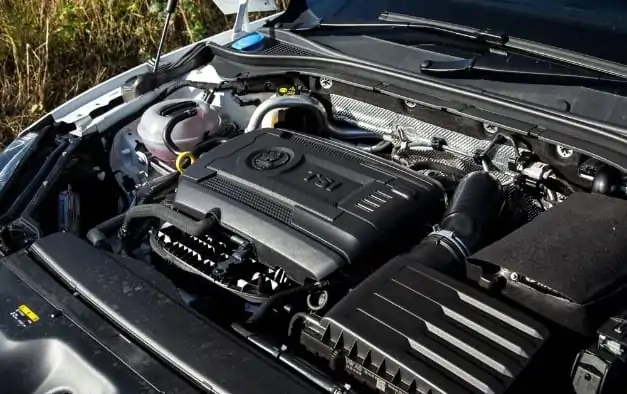
Несмотря на оснащение многих ТС другими типами моторов («чистые» автомобили, работающие от электротяги), ДВС еще долгое время будут сохранять конкурентные позиции благодаря своей доступности. Гибридные и электрические версии авто набирают популярность, однако из-за дороговизны таких ТС и стоимости их обслуживания они пока не доступны рядовому автомобилисту.
Распространенные вопросы:
Что такое двигатель внутреннего сгорания? Это разновидность силовых агрегатов, где в конструкции предусмотрена закрытая камера сгорания, в которой образуется тепловая энергия (за счет воспламенения топливно-воздушной смеси) и преобразуется в механическую.
Кто изобрёл двигатель внутреннего сгорания? Образец первого в мире двигателя внутреннего сгорания был открыт французским изобретателем Этвеном Ленуаром в 1860 году. Первый четырехтактный двигатель внутреннего сгорания, по схеме которой работают абсолютно все силовые агрегаты, изобрел Николаус Отто.
Из чего состоит двигатель? Простейший ДВС состоит из блока цилиндров, в котором установлена кривошипно-шатунная система, цилиндро-поршневая группа, сверху блок накрыт головкой блока цилиндров с газораспределительным механизмом (распредвал и клапана), впускная и выпускная система, топливная и система зажигания.

